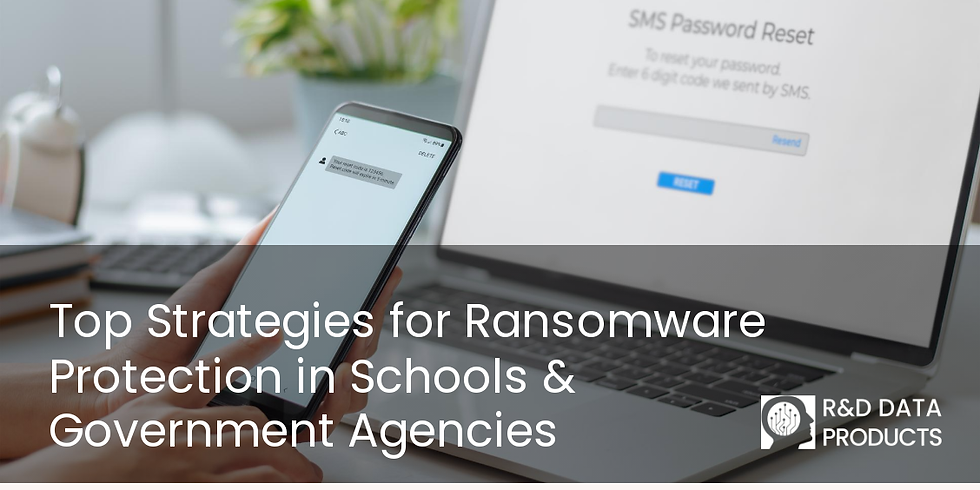Essential Cyber Hygiene Practices for Public Sector Employees
- Dillon Diatlo
- Jul 17
- 3 min read

With schools, municipalities, and government agencies facing growing cybersecurity threats, one weak link is all it takes to bring down a network. And more often than not, that weak link is human.
Training staff in essential cyber hygiene practices is one of the most affordable and effective ways to protect sensitive data, prevent breaches, and comply with regulations like FERPA, HIPAA, and NIST.
This guide outlines the core behaviors, tools, and habits every public sector employee should follow to strengthen your organization’s first line of defense.
Table of Contents
1. What Is Cyber Hygiene and Why Does It Matter?
Cyber hygiene refers to routine behaviors and best practices that reduce your organization’s risk of a cyberattack. Much like washing your hands prevents illness, daily digital habits prevent malware, phishing, and data leaks.
Cybercriminals love to target public employees because:
Many use unsecured personal devices for work
Login credentials are often reused or weak
Phishing awareness is still low
Agencies may lack formal training programs
2. Must-Know Practices for Every Employee
Use Strong, Unique Passwords Avoid common passwords like “123456” or names of pets. Use a password manager to create and store complex, unique passwords for each service.
Think Before You Click Phishing emails mimic real senders. If you didn’t expect it, don’t click. Hover over links, and double-check the sender's email address.
Don’t Ignore Software Updates Those annoying popups? They're patching security flaws. Update all devices promptly—especially browsers and operating systems.
Lock Your Screens Always lock your computer when stepping away, even briefly. This prevents unauthorized access from visitors, students, or coworkers.
Never Share Your Login No one—not your IT team, not your supervisor—should ever ask for your password.
Avoid Public Wi-Fi for Sensitive Tasks Never access sensitive systems on hotel or café Wi-Fi without using a secure VPN.
3. IT Department Policies That Support Good Hygiene
To build a culture of security, your IT department should:
Implement Multi-Factor Authentication (MFA)
Run regular phishing simulations
Disable USB ports on public workstations
Restrict admin privileges to IT staff
Enforce screen timeout policies and strong password requirements
4. Tools That Help Reinforce Safe Habits
Fortinet Security Awareness & Training
Provides gamified lessons and phishing tests tailored to public sector users. Tracks engagement and improves behavioral change. Learn more
Palo Alto Networks Prisma Access
Securely connects remote users to critical systems. Prevents risky behavior by enforcing secure web access policies. Learn more
Extreme Networks
Delivers user-based access policies, letting IT limit what each user can access. Helps isolate risky behavior before it spreads. Learn more
Scale Computing Built-in ransomware protection and backup tools reduce the impact of human error and failed updates. Learn more
5. Summary Table: Public Sector Cyber Hygiene Checklist
PRACTICE / POLICY | WHY IT MATTERS | TOOLS THAT HELP |
Use Strong Passwords | Prevent unauthorized access | Password Managers, MFA |
Avoid Phishing Emails | Stop credential theft and malware infections | Fortinet, phishing simulations |
Keep Software Updated | Close known security gaps | Fortinet, OS automation tools |
Lock Screens | Prevent shoulder surfing and unauthorized access | Group Policy, timeout settings |
Enforce MFA | Adds second layer of login protection | Palo Alto, Fortinet |
Limit Admin Privileges | Reduces risk of accidental or malicious changes | Extreme Networks |
Segment Network Access | Isolate user-level threats | Extreme Networks, Fortinet NGFW |
Train Continuously | Builds long-term behavioral change | Fortinet Awareness & Training |
Need help improving staff cybersecurity habits?
R&D Data Products can help design a layered defense that includes staff training, endpoint security, and network segmentation.



Comments